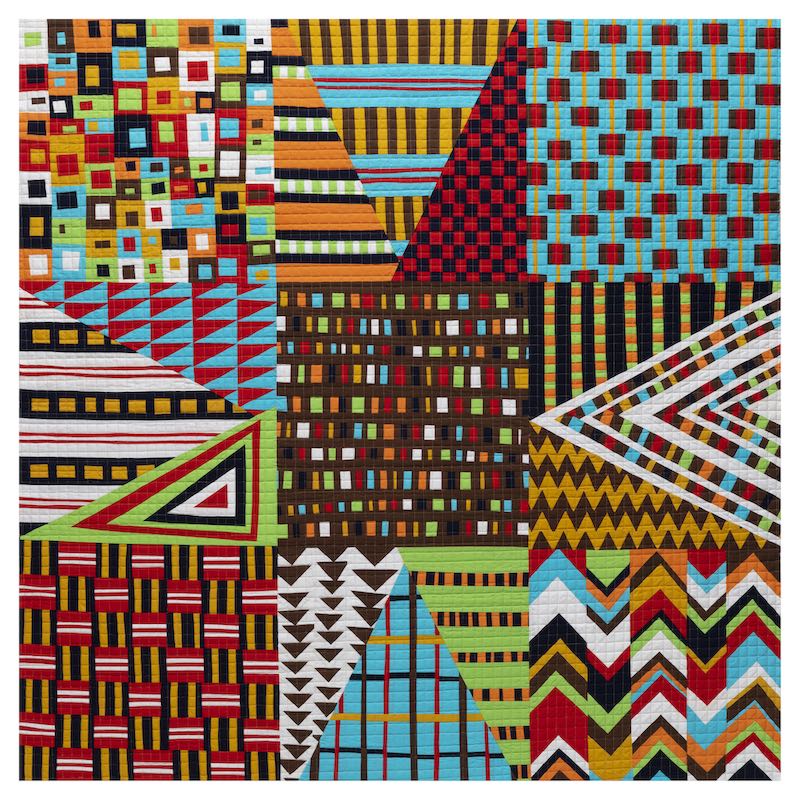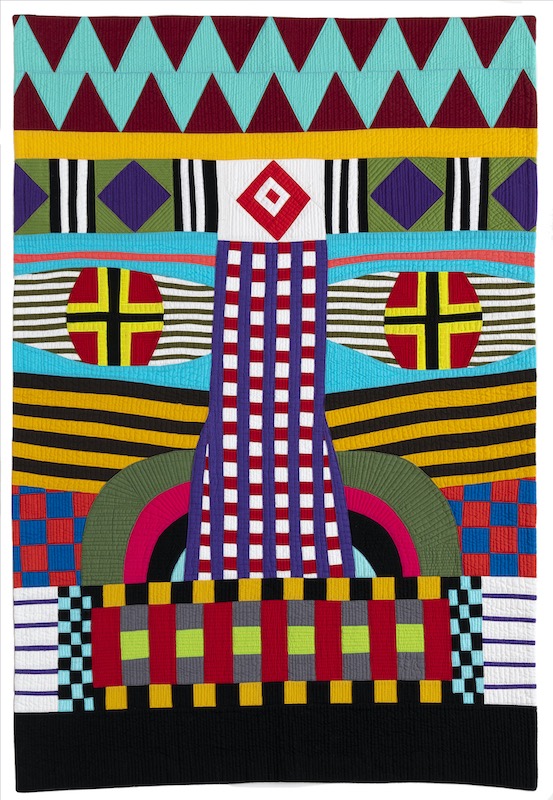Modern quilter Maria Shell is known for improvisation, but thorough planning and adherence to design principles are the foundation of each piece of fiber art she creates. Improv based on knowledge produces a uniquely-ordered – rather than chaotic – way of seeing (or hearing in music or tasting in cooking) the world. So if you look carefully at Maria’s modern quilts, you will see hints of traditional quilt blocks that she takes on an all-new meticulously crafted journey.

Why textiles? Why quiltmaking? How did you get started?
I have always sewn. Beginning early, I started hand sewing when I was four, and I got my first sewing machine when I was ten. I had a Barbie Doll “clothing business”, then I worked in the costume shop in college. Sewing has always been a part of who I am, but I had never made a quilt. Once I stitched my first quilt, I felt as if I got a glimpse of my RIGHT PATH. Now, all I had to do was get on the path and stitch.
What inspires you to work improvisationally?
I struggle with being called an improv quilter. I am so totally controlling! That said, however, I am working with a couple of paper piecers on a team workshop. They wanted to do the math and create a structure for building units to fit together, and then I realized, wow. I guess when you look at the entire spectrum of what quilt making is, I am over in the improv camp. When it comes to craft, I am very meticulous, but very improv when it comes to design. I never know what is going to happen until it does. I just try and create the environment for the ideas to be realized in stitch.
As an Amazon Associate I earn from qualifying purchases. Read more about our affiliate linking policy.

Many people think “haphazard” when they hear “improv”, but it’s far from that. Can you give us some insight into the underlying structure of improvisational piecing?
What I tell my students is that improv has a very rich tradition. There is improv jazz, and improv comedy, and improv quilting. All three of these genres require mastery. You can’t go on stage and improv music without an obsessive knowledge of that music. The same is true for improv quilting.

Is your favorite color “all of the above”? What drives the color decisions in your work?
Color is a such a huge topic! I will say this. I think quilters need to cultivate a professional relationship with color. We all have our personal feelings about color—Brown is boring. Turquoise is the best! But preferences should not be part of selecting color for a quilt composition. Color is a design element. So we need to be thinking about color as being a tool that does a particular job within our quilt compositions.

How do you make the leap from the idea in your head to the art you create?
I do sketch a lot. Often the scraps from one quilt become the fodder for the next quilt. Most of my quilts are built out of units. I might sketch a particular idea and then build the units. Once the units are made, I will often put them on my design wall and play around with them. I take photos and often those photos lead to my next sketch and then my next quilt. The process repeats itself over and over again.


What is the most important takeaway you want readers to gain from your new book, Improv Patchwork: Dynamic Quilts Made with Line & Shape?
The book is meant to be a manual for making pieced units based on common quilt units—the stripe, the triangle, the grid. Once you get the hang of making a few units you can take those units and build your own original composition. The takeaway is that you are your own quilter.
Do you work in series? For you, what makes a compelling subject for a series of work?
Yes, I have several series in progress. The one most people are familiar with is my color grid series. It is based on three simple quilt units—the cross block, the crossed square block, and the quarter log cabin block. I find traditional quilt blocks to be excellent fodder for series work. Within the structure of the traditional quilt block there are endless variations to explore.
You refer to A Room of One’s Own by Virginia Woolf as pivotal reading for artists. How so?
Many makers feel that they should not claim personal space for making. Making is a vital part of a healthy life—it feeds the mind, the hands, and the heart, but in order for that to happen, we must claim our space for doing so. That is what Virginia Woolf is advocating for women writers, and I am just extending that idea to all creatives.

How does your studio organization contribute to your work process?
Well, I tend to not like to stop quilting to clean up. So, things start to pile up, and while I let that happen, it is not good. I am currently working to train myself to clean up on a regular basis. So far, I have trained myself to cut fabric, and then fold it and put it in pile. I used to just make fabric mountains! But now I have folded fabric piles.

What are the indispensable tools and materials in your studio and how do they improve your work?
Good question! These are the things that I love—a super hot steam iron, a well padded ironing board, a 60MM Olfa Straight handle rotary cutter, the 4’’ x 14’’ Omnigrid ruler with old school markings, a clean design wall, a big sturdy work journal for sketching and note taking, as well as lots of tiny snips.

Do you use a sketchbook or journal? How does that help your work develop?
I am a big advocate for sketching. So I don’t really understand how quilters get by without sketching. Sometimes I am just making lists and jotting down stitch orders or measurements which is really not sketching, but note taking. Still, I believe that keeping everything in large journals is crucial to documenting my ideas.

What plays in the background while you work? Silence? Music, audiobooks, podcasts, movies? If so, what kind?
When I am in the design process, I am almost always working in silence. But if I am quilting or doing finishing work, I love to listen to Audible books.


Which textile artists do you admire? Is there anyone whose work you think should have greater recognition in the art world?
I love many female artists. Some of my favorites are Agnes Martin, Ruth Asawa, Anni Albers, Yayoi Kusama, Marina Abramović and Hilma af Klint.

How important are connections with other fiber artists?
On a daily or monthly basis, I mostly work isolation. So I don’t get out much. That said, I am a member of the Modern Quilt Guild and SAQA, and I do love to interact with other artists at QuiltCon, the SAQA Conference, as well as in Houston at the International Quilt Festival. I really missed those gatherings during 2020.

Do you think that creativity comes naturally to people, or do you think creativity is a skill that people can learn?
Creativity is like a muscle, so the more you use it the stronger it gets. Can I run a marathon? YES! But can I be an Olympic gold medalist? Probably not, but that should not stop me from training and running. The same is true for creativity. Being your best is really all that matters. You wouldn’t stop running just because you aren’t going to represent the USA in major sporting competitions. The same is true for creativity. So just do your version of being creative and you will reap all kinds of benefits in your life from doing that. Exercising our creative muscles benefits all aspects of our lives, and you will only get better the more you work at it.

How can people overcome the challenges they feel to their creative ability?
Turn off the negative voice in your head and do the work. That is all it takes. I know that those two things are hard, but that is really all it is. That mean voice in your head has no place in your creative process. Train yourself to TURN IT OFF, then get busy and make some quilts!

Tell us about your blog and website. What do you hope people will gain by visiting?
My blog is a document of my life as a creative. There is a mixture of tutorials, ideas, news, and events. I don’t take myself too seriously and my blog is a place where I can share my work with a bit of humor.


Do you lecture or teach workshops? How can students/organizers get in touch with you to schedule an event?
I teach all manner of workshops! I currently offer monthly virtual ZOOM workshops as well as teaching for guilds and festivals. You can find out more on my website.
Facebook—Maria “the Stitcher” Shell
Instagram—Tales of a Stitcher
Blog—Tales of a Stitcher
Website— MariaShell.com
Interview posted August 2021
Browse through more inspiring modern quilts on Create Whimsy.

